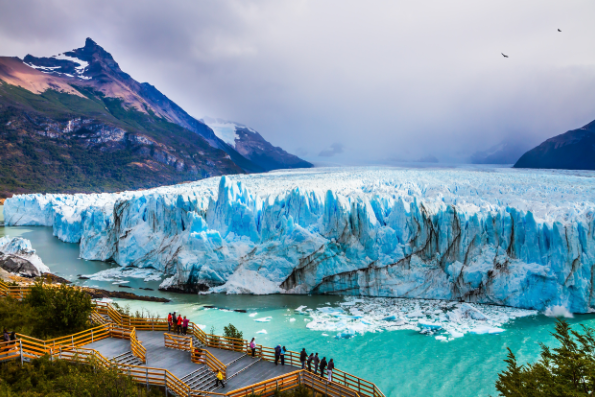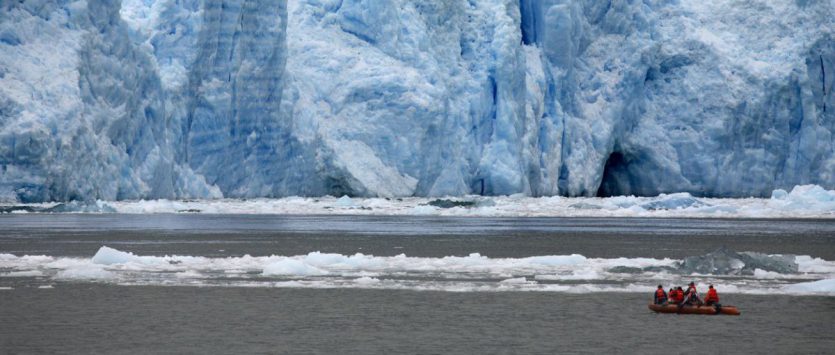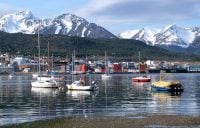Due to the complexity of glaciers, there are many different kinds. Broadly speaking, glaciers are divided into two groups: alpine glaciers and ice sheets. From here, depending on the part of the glacier or where it travels, they can be divided into further subgroups.
Ice Sheets
Continental Ice Sheets
The largest type of glacier is a continental ice sheet. The definition of an ice sheet is a glacier that covers an area of over 50,000km2. These glaciers are so thick they completely conceal topographical features like mountains and valleys. Once, millions of years ago, these vast areas of glacial ice covered much of the Earth’s surface. Now, they are only found in Antarctica and Greenland.
Ice caps & ice fields
By contrast, an ice cap or ice field covers an area of less than 50,000 km2. However, an ice cap or ice field can also completely cover peaks in mountainous areas, such as the ice fields found in Patagonia. These enormous glacial formations can feed many other types of glacier, which spread out from their center.
Outlet glaciers
Glaciers that flow out of ice sheets, icefields or ice caps are called outlet glaciers. The flow of outlet glaciers is affected by the landscape, travelling through valleys and exposed rock. An outlet glacier often continues through these rocky channels to become a valley glacier. An example of an outlet glacier is the Lambert Glacier in Antarctica. The Lambert Glacier is the largest glacier in the world, draining roughly 16 percent of the Antarctic ice sheet out towards the ocean. Furthermore, it’s also one of the world’s fastest ‘galloping glaciers’.

Alpine Glaciers
Valley glaciers
Outlet glaciers can slide away from ice sheets, creating valley glaciers. However, valley glaciers can also form by themselves in mountain ranges. Starting high up near mountain peaks, a valley glacier will flow down between the steep sides of two mountains. As a result, the enormous eroding power of the glacier will cut a U-shaped valley. Steep-sided, flat-floored valleys carved by ancient glaciers can be found in locations like Yosemite National Park, California.
Hanging glaciers
A hanging glacier will generally begin high in the mountains, feeding into a valley glacier. However, unlike the smooth meeting of a river with its tributaries, a hanging glaciers tower over the edge of cliff-faces like enormous frozen waterfalls. For example, the mighty Tronador or ‘thunder’ glacier in northern Patagonia earned its name from the sound of the ice crashing into the bowl-shaped valley below.
Cirque glaciers
Cirque glaciers occur in mountain ranges where dips and crevasses in the topography allow snow to collect and compact. When the glaciers form, they begin to erode large, bowl-shaped valleys known as cirques or corries. Sometimes, cirque glaciers will become so full that they’ll spill over the side of the mountain, creating valley glaciers. Discover more facts about glaciers in this article: 7 fascinating facts about Upsala Glacier in Los Glaciares National Park.

Everything in between
Tidewater glaciers
Tidewater glaciers flow into the ocean, either from ice sheets or alpine glaciers. Tidewater glaciers will ‘calve’ ice as they move forward, where parts break off and fall into the ocean. Many of the glaciers in the Northern and Southern Patagonian Ice Fields are tidewater glaciers. Interestingly, due to their extreme and protracted cycles of advancement and recession, tidewater glaciers are less sensitive to climate change.
Piedmont glaciers
A piedmont glacier forms when a glacier emerges out of a rocky channel onto a flat plain, creating what is effectively a gigantic frozen puddle. For example, in the late 1800s explorers described the San Rafael Glacier in the Northern Patagonian Ice Field as having a large bulbous front called a ‘piedmont lobe’. As is usual with tidewater glaciers, the San Rafael Glacier has now receded, losing its piedmont front.
Rock glaciers
All glaciers contain some type of rock and debris, known as moraine. However, a glacier is defined as a rock glacier when it carries a particularly large concentration of debris. Usually, rock glaciers will look more like a huge, dense mudslide rather than a river of ice. Due to their density, rock glaciers are particularly slow-moving and can occur as part of ice sheets or alpine glaciers.
No comments yet
There are no comments on this post yet.






Leave a comment